Other Measures
63. Retro reflective Materials
PURPOSE In this session, you will gain an understanding of the factors affecting the detection and recognition of pedestrians in our visually complex urban environment. The special problems associated with motorists' vision at night and under low-light conditions are introduced, along with the physiology and psychology of "seeing". The characteristics of high-contrast, fluorescent, reflective and retro reflective materials are discussed in terms of their conspicuity under various conditions. Glare, aging, disease, speed and specific environmental conditions also affect the ability to detect and recognize objects.
A. Knowing the Enemy
When speaking with motorists who have been involved in crashes with pedestrians or bicyclists one statement is commonly heard, "I never saw them, until it was too late to do anything." For this reason, it is critically important that pedestrians and cyclists make an effort to stand out against the traffic background --to be conspicuous.
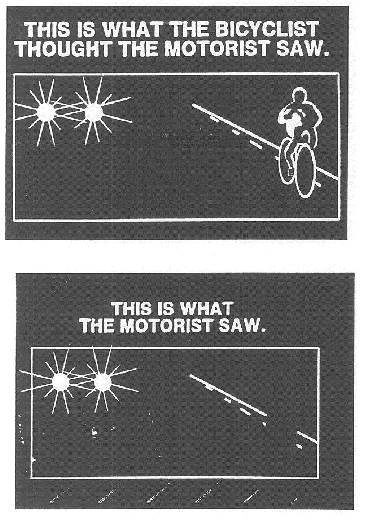 |
This section looks at the topic of conspicuity - being seen or standing
out, in traffic." Primary factors that affect conspicuity include selective perception, environment, aging and darkness.
Following are brief discussions of each factor, followed by definition of different types of in-conspicuity and information on ways to increase conspicuity for pedestrians.
1. Selective Perception
Among the biggest enemies of pedestrians is the phenomenon of selective perception. People tend to see what they are looking for and to overlook things in which they have no interest. When most motorists drive, they usually search for the things that are most likely to damage their vehicle or cause them injury -- other motorist.. Pedestrians and bicyclists get lost in the back-ground and are overlooked. They are not conspicuous!
2. Environmental Factors
Environmental factors can also affect the visibility of pedestrians and bicyclists to motorists. Rain, snow, smoke, fog, wind-driven precipitation, shadows and glare all reduce visual range and acuity.
Man-made aspects of the environment are equally important. Dirty or cracked wind-shields not only reduce vision, but magnify the effects of glare.
 |
3. Aging
As people age, some aspects of their vision often deteriorate, and a loss of visual acuity results. This deterioration becomes especially hazardous when it affects older people who drive motor vehicles. Among the effects of aging is increased sensitivity to glare. Aging also significantly reduces night vision, with people losing about one half of their night vision every 13 years. As eyes age, and the muscles of the eye lose flexibility and resilience, their ability to focus clearly diminishes. Many of these losses are permanent and cannot be ameliorated with corrective lenses.
 |
 |
In winter, some people must go to work, play or school when it is dark or when light conditions are severely reduced. As noted earlier, nearly half of the fatal pedestrian crashes and almost one-third of fatal bicyclist crashes occur in low-light or dark conditions.' All of the factors affecting conspicuity become increasingly critical during times of reduced light or darkness.
B. Three Types of IN-conspicuity
There are three types of in-conspicuity that affect pedestrians and bicyclists: invisible objects, obstructed objects and visible objects not seen.
1. Invisible Object
The first is the invisible object. This type of object blends into its background. It does not stand out -- is not conspicuous. A classic example of an invisible object is a polar bear in a snow storm. Another example .pedestrian in dark clothes walking at night on a unlighted.
 |
2. Obstructed Object
In the second type, the obstructed object, the view of the pedestrian is obstructed by a pole, parked car, truck, bus, tree or other object. A pedestrian who steps off a curb in front of a bus is often an obstructed object. Because of the visual screen represented by the bus, neither the pedestrian nor the approaching motorist can see each another.
 |
The third type is the visible object not seen. An object expected to be visible may be intermittently hidden from view by shadows, glare or other conditions as he or she walks along. Let's look an example of this factor. In winter months, there is a marked increase in the number of crashes involving older pedestrians. As people shift to warmer clothing, most tend to wear dark or neutral colors. Even in the daytime, the lower sun angles create longer shadows. Dark winter clothing becomes camouflage and older pedestrians tend to become invisible people as they walk in the lengthened shadows of trees and buildings.
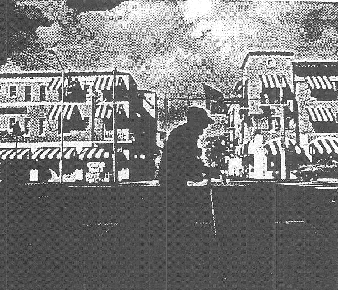 |
Most of us take our vision for granted, but it is an exceptionally important part of how we perceive and learn about our environment. For most people, "to see" takes little or no conscious thought. But the process of seeing -- particularly while driving a motor vehicle -- is actually a complex, five-step sequence of psychological events. Although an overview of this sequence was discussed in an earlier session of the course (V. Pedestrian Crashes), additional information relevant to the subject of conspicuity is provided below.
STEP 1. Search
The first step in the process of "seeing" is searching. In this phase the brain must take input from the scanning eye and identify the stimulus it has learned to recognize as being important enough to warrant further attention.
 |
STEP 2: Detection
The second step is detection. In this phase the brain must sort through the thousands of bits of information the optic nerve is sending. It must defect the object to which it wishes to pay closer attention and then direct the eye to focus
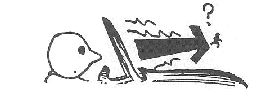 |
STEP 3: Evaluation
The third step is evaluation. The brain has just directed the eyes to focus more attention on the object in question. The brain now has to search its long-term memory to see if it recognizes this object from past experience.
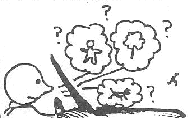 |
STEP 4: Decision
The next step is decision. After recognizing the object, the brain has to analyze all the data coming through the eyes to judge the objects speed, position in traffic, distance away from the vehicle, direction of travel and other factors and to decide upon an appropriate course of action.
 |
STEP 5: Action
The final step is action. After fixing the location of the pedestrian the motorist must react to what has been seen based on decisions made in Step 4. If the motorist reacts soon enough, a crash can be avoided.
 |
D. Increasing Conspicuity
The keys to increasing conspicuity are:
- making people aware of what conspicuity is and of how it affects pedestrians, motorists; and
- showing people how they can become more conspicuous when they walk.
Three ways of increasing conspicuity will be discussed:
- use of conspicuity devices such as clothing and equipment,.
- avoidance of visual screens; and
- programs for training and education.
1. Conspicuity Devices
The searching eye is attracted to size, intensity, repetition, and movement. A device which incorporates one or more of these attributes will greatly speed up the detection-reaction process.
When choosing conspicuity devices, select items which will provide bright steady light, a flashing light or a moving light or reflection. A variety of materials and devices are available that can increase conspicuity to varying degrees, under varying conditions.
The surest way for bicyclists and pedestrians to improve conspicuity is through the use of fluorescent clothing in the daytime and retro-reflective materials at night. "Wear white at night" isn't enough! Let's look at commonly available conspicuity devices to see how effective they are.
a. Contrast
Contrast is one factor that can increase conspicuity. A person wearing several contrasting colors or colors that stand out against the prevalent background color tends to be more conspicuous than a person wearing only one color or a color that blends in with its surroundings. Contrast is not as effective a conspicuity measure as use of fluorescent, reflective or retro reflective materials, but has historically been recommended as a basic safety measure that can be taken by anyone, at no cost.
 |
b. Fluorescent Materials
Fluorescent materials reflect more light than they absorb. Common fluorescent colors are blaze orange, hot pink and day-glo green. These colors seem to amplify light and cause the wearer to stand out in a crowd. Fluorescent colors are excellent for increasing conspicuity in daytime and under low-light conditions but are nearly worthless at night, when they tend to appear to be black.
If a person doesn't want to wear an entire item of apparel out of fluorescent material, conspicuity can still be improved by attaching a strip of the material to a coat, around an arm, to bicycle handlebars or to a purse. Anything that will cause a scanning eye to detect something out of the ordinary will increase conspicuity.
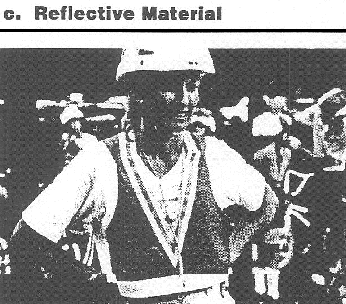 |
Reflective material is most effective when lights are shining directly at it. As the lights' angle increases away from 90 degrees, the material becomes less effective. If lights are coming from an angle of more than about 3 degrees off a direct line in any direction from the object (bicyclist or pedestrian) the reflector's effectiveness is seriously reduced. Be sure either to use a large piece of reflective material to increase the area that can reflect light or use multiple reflective devices.
A few years ago, small reflective dots were a popular item marketed to increase pedestrian safety. While these dots did reflect light, they were very small and didn't communicate enough information to motorists to increase recognition time sufficiently. Motorists could see something up ahead, but couldn't recognize it quickly as a bicyclist or pedestrian. The best way to create a signature that can be easily recognized at night is to reflectorize the pedestrian's limbs --to create an outline.
 |
Arms and legs have a distinctive motion when bicyclists and pedestrians are on the move. Movement is one of the cues the brain uses to direct its attention. A reflector that is moving will be seen much more quickly than one that is stationary. Reflectors on bikes or on pedestrians will be seen by motorists sooner if they are mounted or worn low and on a moving part. Low-beam headlights are aimed down and toward the right shoulder, enabling drivers to spot low reflectors first.
d. Retro reflective Material
Use of retro reflective materials is the most effective way to increase conspicuity at night or under low-light conditions. These materials are not conspicuous in daylight.
Retro reflective material is made using tiny glass beads which reflect light directly back toward its source, from a much wider angle than reflective material.
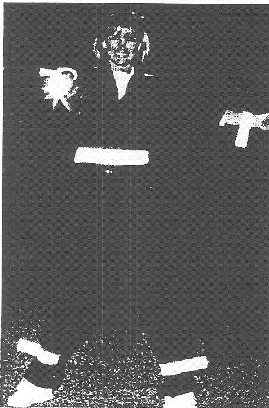 |
Retro reflective material can help create a visual "signature" pedestrians at night or under low-light conditions. As we mentioned earlier, the signature helps the motorist identify the "thing up ahead" as a pedestrian rather than a fence post, motorcycle or snowplow. If the time it takes the motorist to detect and recognize a pedestrian or bicyclist can be reduced, there is more time to react and to avoid a crash if necessary. best reflector.
e. Lights -- Steady and Flashing
At night, lights can do more than any other device to increase conspicuity. They can be combined with clothing and equipment to create a distinctive and conspicuous image. They also light the way for the pedestrian, showing the path ahead.
A steadily burning red taillight is detected and recognized much sooner than even best reflector. Flashing lights are even better.
 |
A flashing taillight combined with a headlight which silhouettes the rider, can greatly enhance safety. Other products such as leg lights and flashing LED lights, are also available. These can be carried, or attached to a limb. They are often combined with various types of reflectorized vests and attachable reflective or retro reflective pieces.
A shining flashlight swinging back and forth in front of a pedestrian, visible to on-coming traffic is very attention-getting. It alerts motorists to the fact that something is moving (and possibly human) up ahead and that rapid reaction may be needed.
E. Visual Screens
A discussion of conspicuity factors would not be complete without mentioning visual screens. A visual screen is anything that obstructs (or screens) a view. It could be a parked vehicle, a tree, a wall, utility poles or a bus in the lane next to you. Visual screens can be avoided, eliminated or counteracted in several ways.
1. Increased Awareness
With increased awareness of visual screens, planners, designers and engineers can avoid creating them in the first place. Walls or bus shelters, for example, can be set back from the curbs to assure that unobstructed sight lines are provided at intersections.
2. Improved Maintenance
Some screens can be eliminated through improved maintenance. Keeping trees and shrubs trimmed back, for example, can greatly improve visibility. Training a maintenance staff to look for and eliminate visual screens is a proactive means of reducing them. A staff which is receptive to reports from the public is essential. Often the users of facilities see things that planners and maintenance overlook.
3. Identification
If you cannot eliminate the visual screens, they should be identified through signs or markings to help people negotiate the area safely. Police can be encouraged to identify many visual screens while on patrol or when investigating crashes.
4. Education
Education of pedestrians and cyclists is also important. Education programs should always include techniques for recognizing and dealing with visual screens. The visual screen presents an edge which pedestrians, in particular, must recognize as the point from which they must conduct their traffic search.
Do you see the bicyclist? (hint: the van is the VISUAL SCREEN!)
Unless the motorist is paying close attention, he or she might not see that bicycle wheel emerging in front of the van!
 |
Unless the bicyclist pays attention, and scans thoroughly to the let?, the right and the left again, he may not see the oncoming vehicle.
 |
Any safety-education program for pedestrians or cyclists, regardless of the ages of the students, should include information on conspicuity and on how to improve the odds of being seen.
For as many years as there has been traffic safety education, the message to pedestrians and bicyclists has been to "wear white at night."
It must be clearly and decisively stated that the message "wear white at night" is not enough to assure the safety of pedestrians in or near traffic at night". If you learn nothing else in this session, remember this! Research has now shown that simply wearing white or light-colored clothing does not provide enough information for motorists to recognize, locate and react properly to pedestrians and bicyclists in or near the road.
After dark and in low-light conditions, pedestrians and cyclists will be most conspicuous if they primarily use retro reflective materials or devices and/or active lights.
The table below shows the time it takes to detect and recognize a bicyclist or pedestrian who uses various types of conspicuity devices.
 |
1. Summary of Key Conspicuity Messages
Following is a summary of key messages about conspicuity to be included in training and education programs.
Day-time Conspicuity
- Wear bright, contrasting colors or fluorescent material.
- Movement attracts attention. Try attaching a scarf to your purse that will flutter in the breeze.
Nighttime Conspicuity
- Pedestrians -- Wear retro reflective materials that outline the human form; carry a flashlight.
- Bicyclists -- Mount active lights on your bicycle, arms, legs or helmet and also use retro reflective materials to outline yourself and your bicycle.
Winter Conspicuity
- If your winter clothing is dark, always wear something light or bright to make you more conspicuous.
- Attach a piece of high-visibility fluorescent material (in daytime) to your purse, briefcase or anything else that is in plain view.
Conspicuity and Left-Turning Vehicles -- Of Particular Concern in Winter
- If you're not sure that a driver has seen you, let the car go by before attempting to cross the street.
- Before you enter an intersection, make sure you look in all directions for on-coming vehicles, especially for turning vehicles. Check the entire intersection for threats.
Sources of Information
Review of the Literature and Programs for Pedestrian and Bicyclist Conspicuity, Dunlap and Associates, for USDOT and NHTSA, National Technical Information Service, Springfield, VA 22161 (1984).
Conspicuity for Pedestrians and Bicyclists: Definition of the Problem, Development and Test of Countermeasures, Dunlap and Associates, for USDOT and NHTSA, DOT HS-806 563, April, 1984. Field experiments were conduced to determine the extent of conspicuity enhancement provided pedestrians and bicyclists at night by various commercially available retro reflective materials and lights. Defection and recognition distances were determined.
A Visible Bicycle, report of a study conducted under the auspices of the Royal Dutch Touring club ANWB, by F. Stoovelaar and R.E. Groot, January, 1976. This study examines the factors determining visual efficiency and the methods used to analyze the visual process. Emphasis is p/aced on the relative importance of recognizabilitv as opposed to visibility or conspicuousness. The contribution of many commonly used conspicuity devices is assessed relative to creating a recognizable signature image for the cyclist.
Enacted Pedestrian Conspicuity Ordinances: Ottawa Hills, Ohio (1981); Montclair, New Jersey (1981) and Charlotte, North Carolina (1983).
Operation Darkness, a road safety campaign on the theme of "Mums and Dads and Children on the Roads", The Women's Motor Transport Corps with the Swedish National Society for Road Safety and the State Road Safety Board, (undated)
Pedal cycle lamps and reflectors -- some visibility tests and surveys, G. R. Watts, Transport and Road Research Laboratory, TRRL Laboratory Report 1108, Department of the Environment, Department of Transport, Vehicle Safety Division, Vehicles and Systems Assessment Department, Transport and Road Research Laboratory, Crowthorne, Berkshire,1984. Observations were carried out to determine the extent to which cyclists comply with lighting regulations and to gather information on lamp reliability and use of conspicuous clothing.
Evaluation of conspicuity aids for pedal cyclists, G. R. Watts, Transport and Road Research Laboratory, TRRL Laboratory Report 1103, Department of the Environment, Department of Transport, Vehicle Safety Division, Vehicles and Systems Assessment Department, Transport and Road Research Laboratory, Crowthorne, Berkshire, 1984. This study examined the effectiveness of conspicuity aids under both day- and nighttime conditions. It looked at vision defection and also measured the gaps left by vehicles overtaking a test cyclist. It recommends bright, highly saturated colors for daytime and retro reflective materials at night.
Notes
- Traffic Safety Facts 1992 - Pedal cyclists and Traffic Safety Facts 1992 - Pedestrians, U.S. Department of Transportation, National Highway Traffic Safety Administration. CONTACT: Ms. Louann Hall at (202)-366-1498 or write to National Center for Statistics and Analysis, NRD-31, 400 Seventh Street, S.W., Washington, D.C. 20590.
- SOURCE: Conspicuity for Pedestrians and Bicyclists: Definition of the Problem, Development and Test of Countermeasures, Dunlap and Associates, for USDOT and NHTSA, DOT HS-806 563, April, 1984.